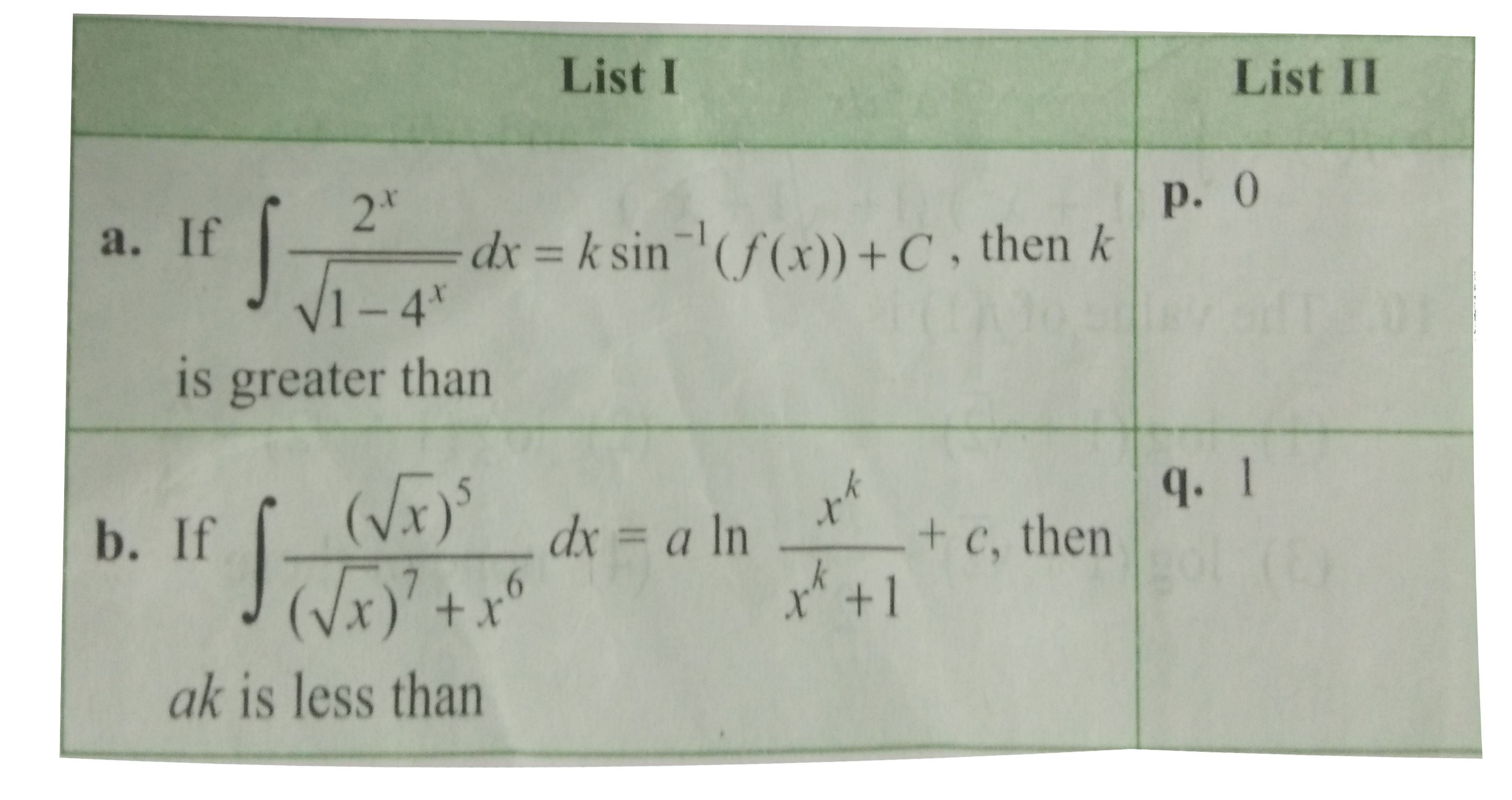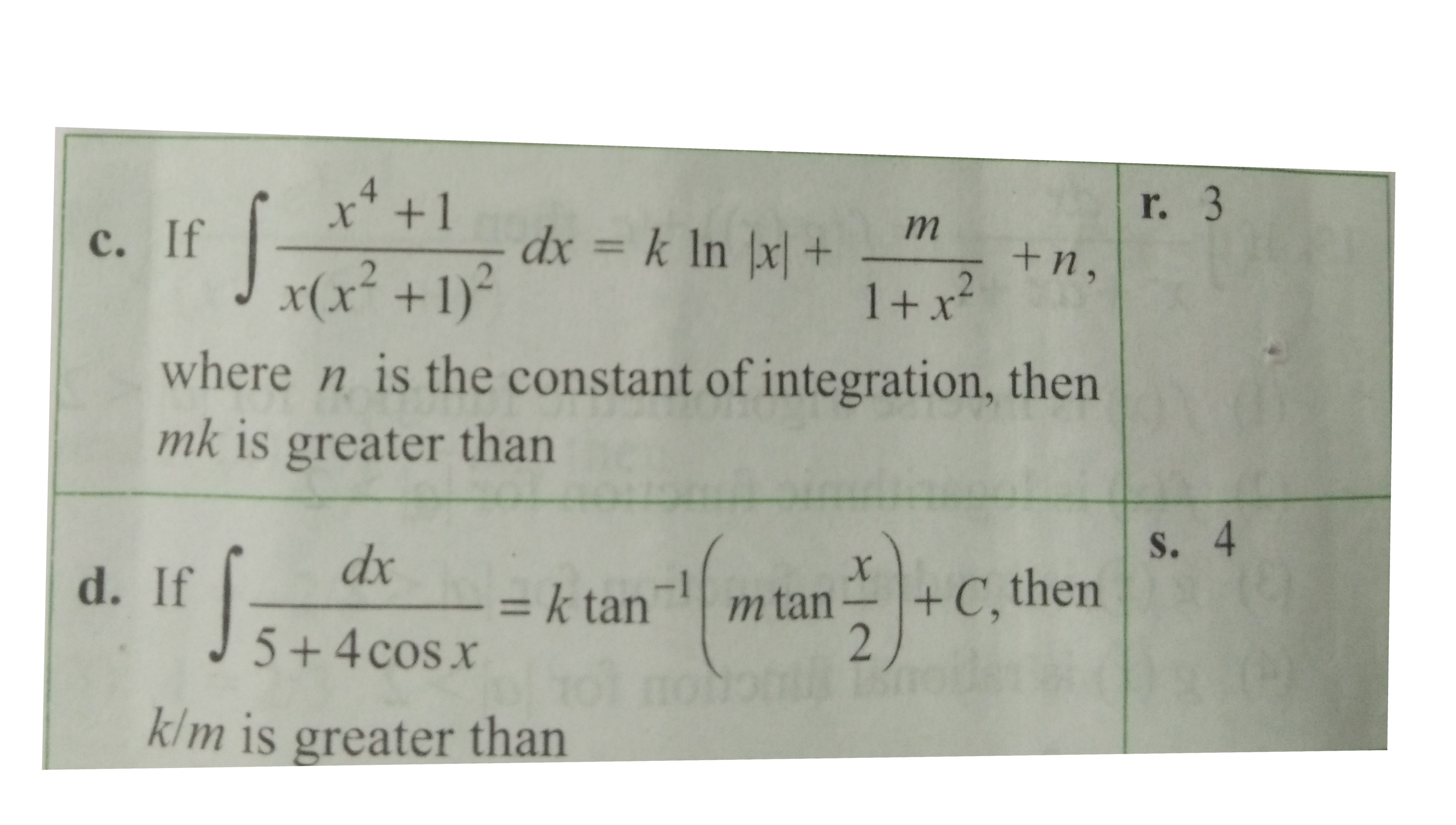If ∫x2−x+1(x2+1)32exdx=exf(x)+c, then (a) f(x) is an even function (b) f(x) is a bounded function (c) the range of f(x) is (0,1) (d) f(x) has two points of extremaSolution in Bengali
f(x) is an even function
f(x) is a bounded function
the range of f(x) is (0, 1]
f(x) has two points of extrema
The correct Answer is:A, B, C
I=∫x2−x+1(x2+1)3/2exdx
=∫ex[x2+1(x2+1)3/2−x(x2+1)3/2]dx
=∫ex[1√x2+1+{−x(x2+1)3/2}]dx
=ex[f(x)+f'(x)]dx, where f(x)=1√x2+1
=exf(x)+c=ex√x2+1+c
The graph of f(x) is given in the figure.

From the graph, f(x) is even, bounded function and has the range (0, 1].
Topper's Solved these Questions
- BOOK - CENGAGE PUBLICATIONCHAPTER - INDEFINITE INTEGRATIONEXERCISE - Exercises (Linked Comprehension Type)17videos
INDEFINITE INTEGRATION
- BOOK - CENGAGE PUBLICATIONCHAPTER - INDEFINITE INTEGRATIONEXERCISE - EXERCISES (Matrix Match Type)4videos
INDEFINITE INTEGRATION
- BOOK - CENGAGE PUBLICATIONCHAPTER - INDEFINITE INTEGRATIONEXERCISE - EXERCISES (Single Correct Answer Type)77videos
INDEFINITE INTEGRATION
- BOOK - CENGAGE PUBLICATIONCHAPTER - HYPERBOLAEXERCISE - COMPREHENSION TYPE2videos
HYPERBOLA
- BOOK - CENGAGE PUBLICATIONCHAPTER - INEQUALITIES AND MODULUSEXERCISE - Single correct Answer21videos
INEQUALITIES AND MODULUS
Similar Questions
y=f(x) is a polynomial function passing through point (0, 1) and which increases in the intervals (1,2)and(3,∞) and decreases in the intervals (∞,1)and(2,3).
If f(1)=−8, then the value of f(2) is04:06View SolutionMatch the following lists:

 01:56View Solution
01:56View SolutionI=∫sin8x−cos8x1−2sin2xcos2xdx is equal to:
02:58View SolutionThe circle x2+y2−8x=0 and hyperbola x29−y24=1 I intersect at the points A and B. Equation of a common tangent with positive slope to the circle as well as to the hyperbola is (A) 2x−√5y−20=0 (B) 2x−√5y+4=0 (C) 3x−4y+8=0 (D) 4x−3y+4=0
05:08View SolutionIf f(x)=ax2+bx+c and f(−1)≥−4, f(1)≤0 and f(3)≥5, then the least value of a is
02:47View SolutionIf ∫x2−x+1(x2+1)32exdx=exf(x)+c,then f(x) is an even function f(x) is a bounded function the range of f(x) is (0,1) f(x) has two points of extrema
04:40View SolutionLet f be a real valued function defined by f(x)=ex−e−|x|ex+e|x| , then the range of f(x) is: (a)R (b) [0,1] (c) [0,1) (d) [0,12)
04:45View SolutionThe integral ∫ex(f(x)+f'(x))dx can be solved by using integration by parts such that: I=∫exf(x)dx+∫exf'(x)dx=exf(x)−∫exf'(x)dx+∫exf'(x)dx=exf(x)+C , and ∫eax(f(x)+f'(x)a)dx=eaxf(x)a+C ,Now answer the question:∫exxx(2+logx)= (A) exxxlogx+C (B) ex+xx+C (C) exx(logx)2+C (D) ex.xx+C
03:43View SolutionThe integral ∫ex(f(x)+f'(x))dx can be solved by using integration by parts such that: I=∫exf(x)dx+∫exf'(x)dx=exf(x)−∫exf'(x)dx+∫exf'(x)dx=exf(x)+C , and ∫eax(f(x)+f'(x)a)dx=eaxf(x)a+C ,Now answer the question:∫ex(2−x2)(1−x)√1−x2dx (A) ex√1−x1+x+C (B) ex√1+x1−x+C (C) ex√2−x2+x+C (D) none of these
View SolutionIf ∫ex(1−x1+x2)2dx=exf(x)+c, then f(x)=
05:30View SolutionIf ∫ex1+x2(1+x)2dx=exf(x)+c, then f(x)=
05:06View SolutionSTATEMENT-1 : ∫dxex+e−x+2=−1ex+1+c
and
STATEMENT-2 : ∫d(f(x))(f(x))2=−1f(x)+c03:50View SolutionIf ∫f'(x)ex2dx=(x−1)ex2+c , then f (x) is
06:23View Solution1.IFf(x)=xxthenf'(e)=A2.Iff(x)=Sin−1xthenf'(1/2)=B3.Iff(x)=Tan−1xthenf'(0)=C4.Iff(x)=exthenf'(e)=D
The ascending order of A,B,C,D is05:36View SolutionIf ∫f'(x)ex2dx=(x−1)ex2+c then f (x) is . . . . .
02:56View SolutionIf ∫ex.23log2xdx=ex.f(x) + C then f(x)=
02:19View Solution

